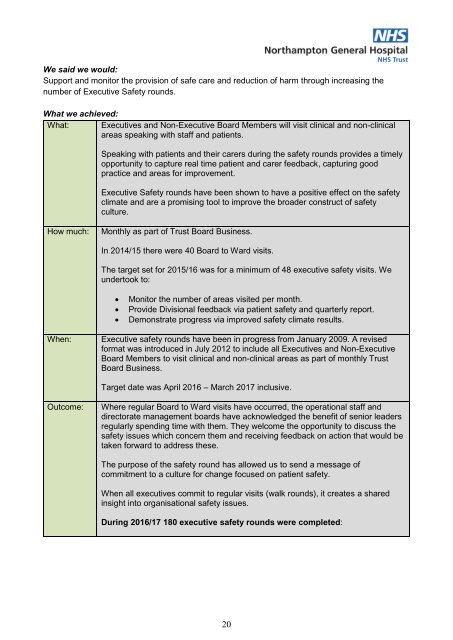Northampton General Hospital NHS Trust Quality Account 2016-2017
Northampton General Hospital NHS Trust Quality account 2016-2017
Northampton General Hospital NHS Trust Quality account 2016-2017
You also want an ePaper? Increase the reach of your titles
YUMPU automatically turns print PDFs into web optimized ePapers that Google loves.
We said we would:<br />
Support and monitor the provision of safe care and reduction of harm through increasing the<br />
number of Executive Safety rounds.<br />
What we achieved:<br />
What: Executives and Non-Executive Board Members will visit clinical and non-clinical<br />
areas speaking with staff and patients.<br />
Speaking with patients and their carers during the safety rounds provides a timely<br />
opportunity to capture real time patient and carer feedback, capturing good<br />
practice and areas for improvement.<br />
Executive Safety rounds have been shown to have a positive effect on the safety<br />
climate and are a promising tool to improve the broader construct of safety<br />
culture.<br />
How much:<br />
Monthly as part of <strong>Trust</strong> Board Business.<br />
In 2014/15 there were 40 Board to Ward visits.<br />
The target set for 2015/16 was for a minimum of 48 executive safety visits. We<br />
undertook to:<br />
<br />
<br />
<br />
Monitor the number of areas visited per month.<br />
Provide Divisional feedback via patient safety and quarterly report.<br />
Demonstrate progress via improved safety climate results.<br />
When:<br />
Executive safety rounds have been in progress from January 2009. A revised<br />
format was introduced in July 2012 to include all Executives and Non-Executive<br />
Board Members to visit clinical and non-clinical areas as part of monthly <strong>Trust</strong><br />
Board Business.<br />
Target date was April <strong>2016</strong> – March <strong>2017</strong> inclusive.<br />
Outcome:<br />
Where regular Board to Ward visits have occurred, the operational staff and<br />
directorate management boards have acknowledged the benefit of senior leaders<br />
regularly spending time with them. They welcome the opportunity to discuss the<br />
safety issues which concern them and receiving feedback on action that would be<br />
taken forward to address these.<br />
The purpose of the safety round has allowed us to send a message of<br />
commitment to a culture for change focused on patient safety.<br />
When all executives commit to regular visits (walk rounds), it creates a shared<br />
insight into organisational safety issues.<br />
During <strong>2016</strong>/17 180 executive safety rounds were completed:<br />
20


